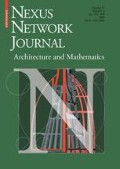Abstract
The complexity shown by some geometrical patterns of Roman mosaics and the high quality of their realization lead to think that for such patterns, unlike scenes with human or animal figures, a model of the general pattern was certainly not sufficient to guide the setting up; in order to answer this question one is led to conjecture the existence of diagrams (key diagrams) with which the craftsman, by looking at them, is able to identify (and/or remember) the geometrical structure of a basic element of the general pattern, as well as a way for constructing it — and possibly the whole pavement — with his usual instruments. This hypothesis is applied to some patterns which were well spread over the Roman world. The present study aims at showing how a given key diagram can apply to varied patterns and, conversely, how the making of a given complex pattern can rely on several articulated key diagrams.
Access this chapter
Tax calculation will be finalised at checkout
Purchases are for personal use only
Preview
Unable to display preview. Download preview PDF.
References
Balmelle, C. and J.-P Darmon. 1986. L’artisan-mosaïste dans l’Antiquité tardive. Réflexion à partir des signatures. In Artistes, artisans et production artistique au Moyen-Âge. Vol. I. Les hommes. Paris: Picard.
Balmelle, C., M. Blanchard-Lemée, J.-P. Darmon, S. Gozlan, M.-P. Raynaud. 2002. Le décor géométrique de la mosaïque romaine. Paris: Picard.
Bar-Shay, A. 1995. Un livre de modèles dans la mosaïque géométrique? Pp. 113–124 in Fifth International Colloquium on Ancient Mosaics, part two. R. Ling, ed. Ann Arbor: University of Michigan Press.
-. 2005. Les modèles polaires (analyse et construction). La géométrie par la corde et les clous. Pp. 833–846 in La mosaïque gréco-romaine IX. H. Morlier, ed. Rome: Ecole française de Rome.
Bassier, C., J.-P. Darmon and J.-L. Tainturier. 1981. La grande mosaïque de Migennes (Yonne). Gallia 39: 123–148.
Bruneau, P. 1987. La mosaïque antique. Coll. Lectures en Sorbonne. Paris: Presses de l’Université Paris-Sorbonne.
Chantriaux, E. et al. 2007. Techniques de dépose et analyse des dessins préparatoires. Au collège Lumière à Besançon (Doubs) (sous la direction de Claudine Munier). Vol. 2: Éléments d’architecture, pp. 257–265. INRAP Direction interrégionale Grand-Est-Sud (Dijon).
Daszewski, A. and D. Michaelides. 1989. Guide des mosaïques de Paphos. Nicosia: Bank of Cyprus Cultural Foundation.
Erlande-Brandebourg, A., R. Pernoud, J. Gimpel, R. Bechmann. 1986. Carnet de Villard de Honnecourt. D’après le manuscrit conservé à la Bibliothèque nationale de Paris (no 19093). Paris: Stock.
Hanoune, R. 1994. Le travail de l’ouvrier mosaïste à Bulla Regia (Tunisie). Pp. 281–283 in La mosaïque gréco-romaine IV. Association Internationale pour l’Etude de la Mosaïque Antique.
INRAP. 2005. Rapport de l’Institut National de Recherches Archéologiques Préventives au Parlement.
Parzysz, B. 2007. Analyse des tracés régulateurs des motifs géométriques des mosaïques. Au collège Lumière à Besançon (Doubs) (sous la direction de Claudine Munier). Vol. 2: Éléments d’architecture, pp. 267–346. INRAP Direction interrégionale Grand-Est-Sud (Dijon)
Prud’homme, R. 1975. Recherche des principes de construction des mosaïques géométriques romaines. Pp. 339–347 in La mosaïque gréco-romaine II. Paris: Picard & CNRS.
Tebby, S. 1994. Geometric mosaics of Roman Britain. Proceedings of the fifth international colloquium on ancient mosaics. P. Johnson, R. Ling, DJ. Smith, eds. (Journal of Roman Archaeology, Supplementary series, 9), vol. 1, 273–94.
Author information
Authors and Affiliations
Editor information
Rights and permissions
Copyright information
© 2009 Kim Williams Books, Turin
About this chapter
Cite this chapter
Parzysz, B. (2009). Using Key Diagrams to Design and Construct Roman Geometric Mosaics?. In: Williams, K. (eds) Nexus Network Journal. Nexus Network Journal, vol 11,2. Birkhäuser Basel. https://doi.org/10.1007/978-3-7643-8976-5_9
Download citation
DOI: https://doi.org/10.1007/978-3-7643-8976-5_9
Publisher Name: Birkhäuser Basel
Print ISBN: 978-3-7643-8975-8
Online ISBN: 978-3-7643-8976-5
eBook Packages: Mathematics and StatisticsMathematics and Statistics (R0)

